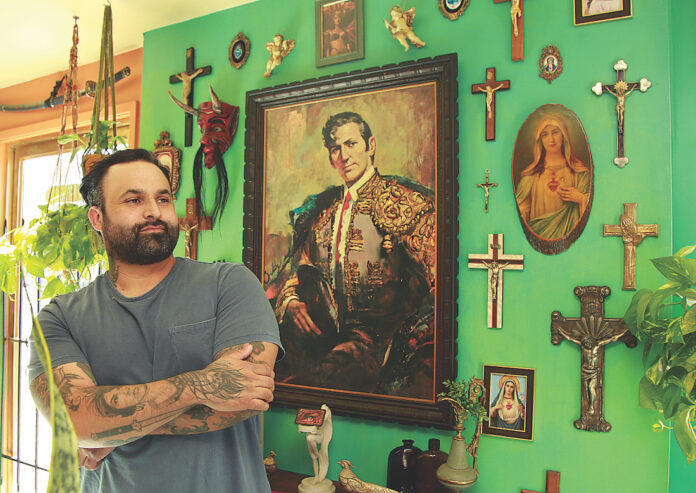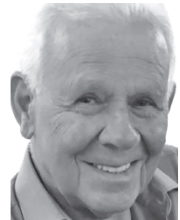WATSONVILLE—After spending more than a decade as a tattoo artist in Silicon Valley, Pepe Nunez has returned home.
Classic Calavera Tattoo is set to open soon in a location near the intersection of Freedom Boulevard and Green Valley Road that previously housed a bike shop.
Even though business was booming at Black Lagoon Tattoo in San Jose, Nunez says he always knew he wanted to return to his hometown to inspire the next generation of local artists and help Watsonville folks tell their stories through his art.
“This was always my goal: to give back to this community,” said Nunez (no relation to this writer). “There’s so much life, a lot of hardworking people, a lot of struggle. There’s a lot of people here that need someone that can help them get across the person they are.”
The walls of Nunez’s eclectic shop feature dozens of prints, photos, paintings, sculptures and religious antiques that he has collected over the years. In many ways, the shop is a reflection of his life.
Nunez says he was a middle child who was largely left to fend for himself. That freedom allowed him to naturally find his way to tattooing in his late 20s. When he searched Santa Cruz County for apprenticeship opportunities he came up empty, so he moved to San Jose and started his career at Strong Tattoo before jumping to Black Lagoon. He worked there for seven years before saving up enough cash to start his own business in Watsonville.
“Everything I’ve gained from other places, I’ve brought back [to Watsonville],” he said.
But his return has been anything but easy.
He received approval from the Watsonville Planning Commission in September last year, but it was more than a year ago that he first started looking into what it would take to set up a tattoo shop inside city limits. What he found was a slew of restrictions on the profession written into Watsonville’s municipal code by former politicians that in 2007 were afraid tattoo shops would empower local gangs and negatively impact the area’s youth.
Tough stance
In Watsonville, Tattoo shops face many of the same restrictions as liquor stores and cannabis dispensaries. They have to be 500 feet away from parks and schools, 750 feet away from another tattoo shop and 300 feet away from a liquor store, bar or restaurant with a bar. They also have to undergo an annual inspection from Watsonville Police Department, and no more than 25% of any window can be covered “with material that obscures the view into the Body Art Facility from the outside”—with no consideration for people who might be getting ink in a private area.
Shops must also go before the Watsonville Planning Commission for an annual review, where they could have their special use permit—which costs $6,000—revoked. And they have to reapply for the pricey permit every five years.
“The ordinance takes a very tough stance on tattoo shops,” said Suzi Merriam, the city’s Community Development Department director.
Merriam says that this was an intentional move by a largely conservative city council that was forced to remove its de facto ban on tattoos that dated back to the 1960s, a time when, according to Pajaronian and city records, thousands of troops stationed at Fort Ord that were coming in and out of the Central Coast during the Vietnam War often visited South Main Street in Watsonville. The fear then was the proliferation of blood-borne pathogens through prostitution, and dirty needles used for tattoos and drugs.
In 2007, however, concerns were much different. Geoff Wells and his mother—and lawyer—Kate Wells were threatening litigation against the city because of the de facto ban. They claimed, as plaintiffs in other cities successfully have, that it was unconstitutional because tattoos are a protected form of free speech. The Watsonville City Council struggled to quickly compromise on the restrictions that tattoo shops should face over fears that the businesses would empower gangs, and the city was sued twice by the Wells family over the course of a two-year battle.
The Wells family eventually persevered, and Freedom Tattoo opened in 2008 just a couple of doors down from where Nunez set up Classic Calavera Tattoo on Freedom Boulevard.
Freedom has since moved from its Watsonville location to a spot off Soquel Drive in Aptos.
Although Wells considers his fight against Watsonville a success, he argues that the current ordinance is yet another de facto prohibition on tattoo shops. If he had not pulled out of Watsonville, he wonders where exactly Nunez would have put his shop. It took him several months to find a location that fit within the restrictions, and he believes it would be even tougher to do so now with additional schools, bars, restaurants and, now, Nunez’s shop within city limits.
“And the sad thing is that no one [on the city council] is going to change the zoning for tattoo shops until someone sues the city again,” Wells said.
Culture clash
Thinking back to the conversations the Watsonville City Council had while it developed the current body art ordinance, then-mayor Manuel Bersamin says that “the Watsonville of that period of time is not the Watsonville of today.”
Specifically, he says that gang violence and crime spiked during the Great Recession, which coincided with the tattoo issue and fueled their fears that a tattoo shop would empower local gangs. He also says that the city council was in the midst of becoming more progressive and Latino.
Still, he says that the false connection the city council made between tattoo shops and gang proliferation—one that the city’s own police force shot down at the time—is difficult to look back on. It was tough then, he says, to separate the Watsonville that he grew up with, a city that struggled with violence and alcoholism because of its large collection of “cantinas” in South Main Street, from the community that Watsonville was becoming.
“I think we were trying so hard to break that stigma that Watsonville had for years that we couldn’t see tattoo shops for what they were,” said Bersamin, 69, who after he left the city council got a tattoo of his mother. “We didn’t know that they’d become something so acceptable in the way they are today, especially in Watsonville.”
Current Watsonville City Councilman Francisco “Paco” Estrada agrees with Bersamin. The child of Mexican immigrants, Estrada, 39, says that the worries the council voiced back in 2007 were the exact conversations he had with his parents when he was younger. For his parents, having a tattoo meant, among other things, that you were in a gang.
“Even though I heard that growing up over and over again, I didn’t believe any of it,” Estrada said with a chuckle. “As I got older, I learned about the reasons why people get tattoos. They tell a story of who these people are—they’re a part of their identity.”
Estrada respected his parent’s wishes and waited until he no longer lived under their household to get a tattoo. Now, he has three, including a sleeve on his left arm that Nunez did for him. He says that his mother was initially sad that he got a tattoo, but “her view on it changed just like her view on a lot of things have changed.”
“My parents aren’t the same sort of traditional Mexican parents that they once were,” he said, adding that their views on things such as LGBTQ+ rights have changed as well.
Nunez says that when he was younger he also associated tattoos with gangs and drugs. It wasn’t until he was out of high school that he saw the attention to detail and artistic prowess that went into the profession. A gifted artist as a kid, Nunez said that he gravitated toward the craft soon after.
“I saw it for what it was, a fine craft,” he said.
He hopes his art can do the same for others. He highlights the fact that he is bilingual—speaking fluently in Spanish and English—and wants to be a resource for Spanish speakers who are interested in getting a tattoo, but have been intimidated because of the language barrier.
“It’s all about making people feel safe, welcomed and taken care of,” he said. “That’s one thing I wanted to bring here, too: quality work for the common working man, all the Mexicanos and all the people that are not bilingual to have somewhere they can go where people can understand them. I want to take care of people here.”










